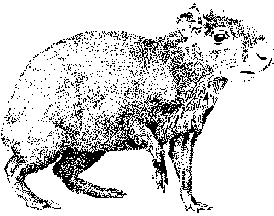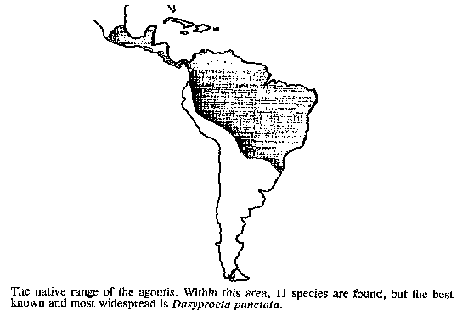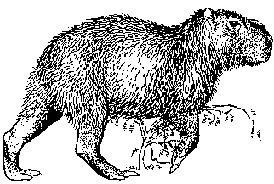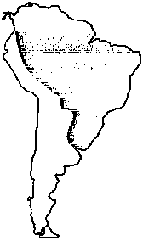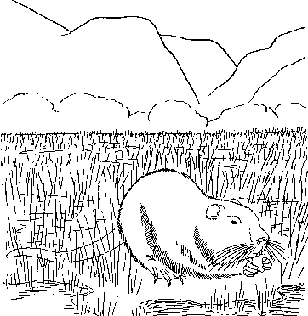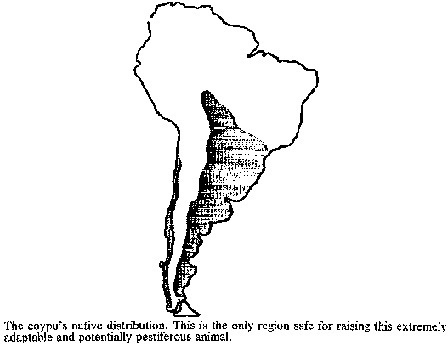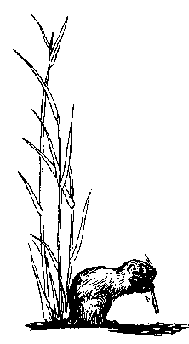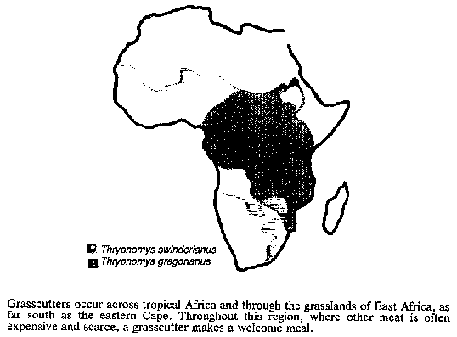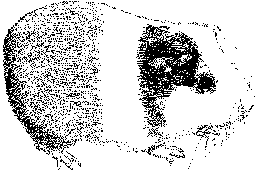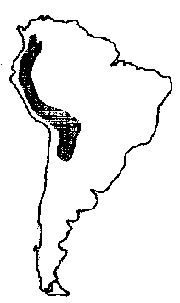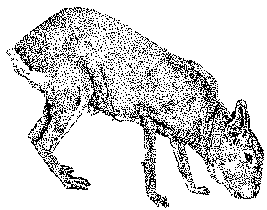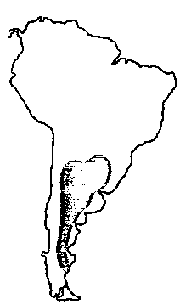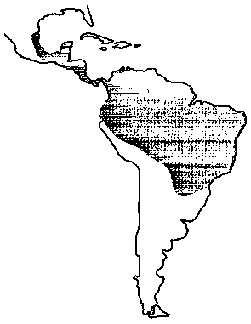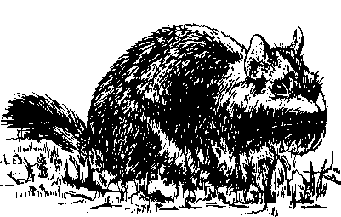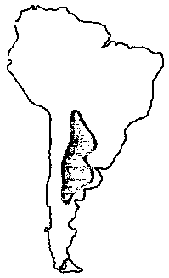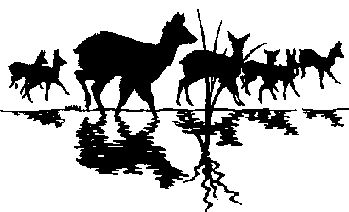Part IV: Rodents
Rodents are the world's most widespread, adaptable, and prolific group of mammals. They reproduce well, grow fast, learn quickly, and adapt to a wide variety of local conditions. Many convert vegetation into meat efficiently, digesting some fiber, even though their stomach, like man's, is a simple one.
It seems probable, therefore, that some species would make suitable microlivestock - a notion supported by the previous domestication of the guinea pig, laboratory rat and mouse, gerbil, and hamster. Indeed, "ranching" rodents might be an effective way to increase food supplies in remote areas. It could also be a mechanism to ensure the survival of rare rodents whose natural habitats are being rapidly destroyed.
RODENTS AS FOOD
Rodents are already common foods in many countries and are valued items of commerce. It has been estimated that 42 of 383 cultures eat rodents.! But the fact that they are a major meat source is almost unrecognized. This is due in part to cultural misunderstanding. Rodents suitable for human food or other products do not live in filth, like common rats. They are clean and vegetarian. Like rabbits, they eat grass and grains.
In some regions of the world, cooked rodent meat is regarded as the epitome of dining. In many countries, local rodent species are the most eagerly sought meats. City markets in different parts of Latin America carry guinea pig, pace, capybara, and vizcacha. Markets in Asia may carry rice rats, cloud rats, and bandicoot rats. Those of rural Africa are filled with "bushmeats" - usually including grasscutters, giant rats, and several other rodent species. These are often preferred to the meat of domestic stock and fetch higher prices than beef. And the amounts of rodent bushmeat available are not minor. In one year, for example, hunters in Botswana have brought to market 3.3 million kg of meat of the rodent called springhare (see page 278).
Fondness for rodent meat is not restricted to the tropics. In the United States, squirrel was once a much sought treat. Fat, nut-fed grey squirrels went into Brunswick stew, which has been called the most famous dish to emerge from the campfires and cabins of Colonial America. Thomas Jefferson liked it. Today, squirrel is the country's number two game animal (after deer), and many are still eaten.
Ancient Romans kept fat dormice in captivity, serving them as a delicacy. "The fat dormice are fattened up in barrel-like pots like those in country houses," wrote Varro (116-27 BC). "One feeds these animals large amounts of acorns, chestnuts, or other nuts."2 This small rodent remains a prized food in Europe and still appears on tables in certain areas. The meat is regarded as a delicacy because it tastes of almonds and other nuts. Often it is roasted, broiled, and cooked with its cracklings.
Rodents have seldom been included in livestock programs or economic development plans. Yet human appetite has actually caused the extinction of a number of species. Caribbean Indians ate several endemic rodents (one of which was as big as a bear), and may have caused several species to become extinct just before the time of Columbus. Others may soon follow the same dismal route, including the beautiful cloud rat of the Philippines, the hare-like mare of Argentina, the vizcacha of southern South America, and the gentle hutias of the Caribbean.
The guinea pig is described in a later chapter, but as it is the epitome of a rodent microlivestock species, some historical background is given here. It was domesticated for food use at least 7,000 years ago, probably in what is now the central highlands of Peru and Bolivia. With only llama and deer available, the prehistoric Andean peoples had few readily available sources of meat. They adopted wild cavies, and found that these rangeland rodents (which are more closely related to porcupines than to rats or mice) were gentle, manageable, and easy to rear. By the time the Spaniards arrived in the 1500s, the "cuy" (pronounced "coo-ee," like the faint cry it makes) was a major food from Argentina to the Caribbean.
This impressed the conquistadores, who introduced cuys into Europe, where they also became a delicacy.3 Within a century, these easily transported animals began to appear on tables in many parts of the Spanish empire. Guinea pigs are now reared in campesino huts in the mountains of central Mexico, in the Philippines, and in several African nations, along with other areas of the world.
Elsewhere, guinea pigs came to be used only as house pets and laboratory animals. Although during World War II Mussolini's government urged Italians to keep them to supplement their meager meat rations, their use as food was largely ignored in most parts of the world.
DOMESTICATION
The idea of domesticating rodents may seem radical, but domestication projects are already under way with capybara in Venezuela (see page 206), pace in Panama (see next page and page 262), giant rat in Nigeria (see page 224), and the grasscutter in Ghana (see page 232). Rodent husbandry is not complicated and the animals' environmental requirements seem relatively simple and easy to satisfy. Moreover, rodents are not usually fastidious feeders, and being essentially vegetarian will readily accept a wide variety of commonly available foodstuffs.
LIMITATIONS
As with most animals with which man is in close contact, rodents can transmit human diseases.4 With care, however, managed rodents need not be any more dangerous to care for or to eat than pigs or horses - both of which are worldwide food resources.
DOMESTICATING RODENTS
To domesticate the pace (see page 262) would seem to be impossible. These large rodents of Central and South America are nocturnal and fiercely territorial; they have low fecundity and take 10 months to reach weaning, and they have tender skin that is easily damaged Most researchers have written them off as candidates for domestication. But at least two have undertaken to beat the odds. We present the findings of one of them here to show that, using modem techniques, even species that normally fight each other to the death on sight are potential farm animals.
Through years of studying paces in Panama, Smithsonian biologist Nicholas Smythe has found that with care and planning the aggressive behavior can be so radically altered that the animals become calm. Indeed, some become almost loving. Newborns, Smythe found, undergo "imprinting" and when he places them with docile adults or with humans, the fierce territoriality never develops. He nurses newborns on "surrogate" mothers that have been imprinted on people. The youngsters then welcome human company and, if fumed out of the cage, return there voluntarily. "It's difficult to imagine a more manageable animal," Smythe said. "Technically speaking they are behaviorally indistinguishable from traditional domestic animals."
As of this writing, Smythe has three generations totalling about 50 individuals, and has several "families" of gentle paces living together in harmony. He has observed that they lose their nocturnal habit and, although they live mainly on fruits in the wild, they readily eat leafy vegetables and other foods in captivity. His captive specimens have recently begun to breed. The offspring remain docile, but they have so far averaged only a little more than two young per female per year.
"If we can just double the reproduction rate, then raising paces can compete economically with raising cattle," Smythe explained. "The potential for a bigger brood is all in the animal's anatomy, and if successful, paces in the wet tropics could produce as much protein as cattle."*
Pacas need the shade and protection of the forest. Thus, pace raising might provide an alternative to cutting down rainforests for cattle raising. Instead of toppling trees and planting pastures, people could farm paces in the forest, and perhaps make as much or more money at the same time. In tropical America, the ready acceptance of pace meat is a near guarantee that all they produce will be snapped up at premium prices. In the past, many territorial and aggressive species have been dismissed as being impossible to domesticate or manage. But Smythe has demonstrated that with imprinting and other methods of behavior modification, these need be dismissed no longer.
Indeed, the pace may already be becoming a new domesticated species. In the first stage of his experiments, Smythe had to train his captive-born paces to be social and nonaggressive. Subsequent generations, however, need no training adopt the new behavior patterns of the parents, and do not revert to aggressive asocial behavior. By the third generation, they have become as accepting of, and indifferent to, people as cattle or sheep.
15 Agouti
Among the best known of all animals of the American tropics, agoutis (Dasyprocta species)' are prolific rabbit- or hare-sized rodents that are probably easily farmed. They are valued for food and are hunted throughout most of their range. Indeed, agouti meat, once common in Latin markets. is now difficult to find because of indiscriminate killing. Agouti hunting is already prohibited in Brazil; restaurants in Belem, for example, once offered a variety of "cotta" (agouti) dishes at prices equivalent to those of choice filet mignon, but since the early 1970s they have been banned from serving it. Other countries will probably have to institute similar bans.
Agoutis are active, long-legged, and high-strung. They flee in panic at the slightest alarm. They do not climb but they do burrow occasionally, being essentially specialized ground-dwellers that live in tropical forest regions.
There have been no organized scientific attempts to raise these swift, shy animals in captivity, but Latin Americans sometimes keep them as "domestics," especially in parks and large gardens. (Agoutis are well known, for instance at the Goeldi Museum in Belem, Brazil.) These animals seem to tame easily, and could perhaps be mass produced on a large scale like rabbits or guinea pigs. They make affectionate pets, sometimes refusing to return to the wild. A research project on captive breeding of two local agouti species (Dasyprocta mexicana and D. punctata) for food is already under way in Tuxtla Gutierrez, Mexico.
AREA OF POTENTIAL USE
Most of lowland, tropical Latin America and the Caribbean.
APPEARANCE AND SIZE
Agoutis are delicately built, graceful, nimble, and beautifully proportioned. They have slender bodies, short ears, and look somewhat like a rabbit that has been "jacked up" in back. Generally, adults are 40-60 cm long and weigh 2-5 kg. Some are even bigger.
They run well and are good jumpers. From a standing start an agouti reportedly can leap as high as 2 m or as far as 6 m; however, as long as they are well fed, there is little problem keeping them behind a wall only 1 m high.2 Reportedly, they sometimes climb easy-sloping trees to collect green fruits, but researchers studying Central American agoutis report that they are strictly terrestrial.3 They swim well.
The body hair is thick, coarse, and glossy: pale orange to black on the back, and white to yellow on the belly. Some species have faint stripes, and some have a rump that contrasts with the rest of the back. The short tail is partially concealed under the long body hair.
DISTRIBUTION
Agoutis occur over a vast area from southern Mexico to Paraguay, including many islands in the Caribbean.4
STATUS
Because they occasionally damage sugarcane plantings and because the meat is particularly tasty, people hunt agoutis relentlessly, especially near cities and towns. Now, in the l990s, they are becoming rare because of excessive hunting and habitat destruction. Many Latin Americans have never heard of them. In Mexico, for instance, there are few places where agoutis survive, and Dasyprocta mexicana may become extinct if habitat destruction and overhunting continue in its restricted range. In Costa Rica and Panama, agoutis occur only where there is little or no hunting or human interference.
HABITAT AND ENVIRONMENT
From sea level to elevations of at least 2,500 m, the adaptable agouti lives in many habitats: moist lowland forests, dry upland forests, thick brush, and savannas. However, although they thrive in secondary growth areas, they are mainly forest dwellers. Nonetheless, they often enter fields to forage, and young animals occasionally are seen in open areas such as grassy stream banks and cultivated fields.
BIOLOGY
Agoutis shelter in hollows among boulders, in riverbanks, or under tree roots. They also hide in heavy brush and sometimes in holes dug out by other species.
These herbivores eat seeds, fruit, stalks, leaves, roots, and other succulent plant parts, as well as occasional insects and fungi.
They seem to mate twice each year. The estrous cycle is variable, but is only about 34 days long. The young are born after a gestation period of 3.5-4 months. Usually, there are twins; however, single births and triplets have been recorded. Newborns are fully developed and are able to run around within hours. They start feeding on solids within a few days. Puberty occurs at about 9 months of age. Life expectancy is 10 years or more.
BEHAVIOR
In the wild, agoutis are shy and retiring. Every sense seems constantly triggered for instantaneous action and sometimes they become hysterical. If danger threatens, they usually "freeze," but when discovered they stamp their feet as an alarm signal and dash away, nimbly dodging obstacles.
Despite excessive timidity, they can be violent among themselves.
In undisturbed forests, agoutis are diurnal and are often seen. But around villages they become nocturnal, as a means of self-preservation.
For the most part, these rodents live in loosely formed pairs, with previous litters living around their territory as "satellites." There is some "bigamy," some "philandering," and some "divorce."5.
Despite their long claws, they display much finger dexterity. To eat, they usually sit erect, crouching on their haunches and holding the food in their forepaws. If it has a skin' they carefully peel it before starting their meal. They save some nonperishable foods (nuts, for instance) by digging holes in scattered locations, dropping each one in a separate location, stamping it down, and covering it over. This behavior helps disperse the seeds of many species of trees so that agoutis benefit tropical forests and reforestation.
USES
As noted, agoutis are popular game animals. They are often hunted with dogs that even follow them into the burrows. Agouti meat is tasty, although it is usually said to fall short of the meat of the pace (see page 262) because it is leaner and gamier.
HUSBANDRY
Agoutis adapt well to captivity. With appropriate care they can be bred without difficulty.6 The nervousness that is pronounced in nature is quickly lost in captivity. The young become tame pets. They can be fed on foods such as leafy vegetables, fruit, potatoes, and bread scraps. Although many wild specimens have become nocturnal, captives readily readapt to daylight.
Being entirely terrestrial, agoutis require no trees, but they do need space. Given enough area, they get on well (with each other and with different species), and they breed freely. To avoid fighting, it seems necessary to separate females from males at puberty. Probably removing progeny from breeding pens at weaning could also help avoid most of the interpersonal aggression. In large areas with plenty of cover (banana plants, for instance), groups can be kept, but breeding may be disappointing. Husbandry may be most appropriate in large enclosures (50-100 agoutis) with some animals then removed to small cages 0.5-1 m° for selective feeding.
ACOUCHIES
Close relatives, the green and red acouchies (Myoprocta acouchy and Myoprocta exilis) also deserve study. These are smaller animals with longer tails, bearing a little plume of white hairs. Although even more delicate and hypersensitive than agoutis, they can be kept in captivity and breed well. They then become less nervous and are easily handled. Acouchies. show remarkable intelligence and even some affection for those they trust. They frequent rainforests, but are rare or even absent in disturbed areas. Adults weigh up to 1.5 kg.
The general biology (diet, reproduction, activity rhythm), is almost the same as that of the agouti, but they live in smaller home ranges (0.6-1.2 hectares versus 2.5 hectares for the agouti) and travel singly, although belonging to a well-established family unit. Adult males tolerate the juvenile males. They occur only in Colombia, the Guianas, Ecuador, Peru, and Brazil.
Farming methods would probably be the same as for the agoutis, but acouchies always need plant cover.
ADVANTAGES
Agoutis are appropriately sized: a dressed carcass can weigh 1-3 kg. The meat is good, and large commercial undertakings in urban centers could profit from the ready market that already exists.
The animals are prolific: females can produce up to two litters a year, each litter averaging two offspring. In protected areas, populations may grow fast.
These forest dwellers might provide a source of meat and income without destroying the forests in favor of cattle pastures. Also, they thrive in disturbed areas as long as there is some cover.
LIMITATIONS
Experiments in Brazil show that agoutis are highly susceptible to foot-and-mouth disease.
The animals might become pests: they eat the roots, leaves, and fruit of agricultural crops and occasionally damage sugarcane and banana plants. However, current experience suggests that if they escape captivity they are quickly caught by hunters and do not reach pest levels.
Live agoutis have strong-smelling anal glands that may be offensive to breeders or could contaminate the meat if the animals are carelessly handled.
Where the rainforest is destroyed, the agouti population is destroyed. The animals were once well known throughout Latin America, but not anymore. In some areas, therefore, wild breeding stock may not be locally available. Moreover, people may have become sufficiently unfamiliar with them that their value may no longer be appreciated.
In captivity, they can be the prey of large birds such as eagles.
RESEARCH AND CONSERVATION NEEDS
The taxonomy of agouti species needs clarification.
Husbandry experiments are required, including studies on topics such as:
- Nutrition;
- Growth rate;
- Shelters and enclosures;
- Reproduction; and
- Techniques for catching, moving, marketing, and managing the animals.
One area where agoutis might profitably be raised is in enclosures in palm plantations. Palms such as the babassu provide food, shade, and shelter, while fallen and rotten logs offer secure retreats from predators. This deserves investigation.8
Instead of clearing vast areas of rainforest for cattle pasture, as is being done in much of Latin America, people might well "farm" agouties in the forests. Few of the settlers flooding into such regions can afford, let alone raise, beef. Small-scale agouti farming offers a promising and inexpensive alternative that would be gentle on the fragile land.
16 Capybara
The capybara (Hydrochoerus hydrochaeris), the world's largest rodent, can be as big as a sheep and weigh as much as a small person. Its natural habitat is the environs of South America's rivers, marshlands, and swamps, where it feeds on the grasses and reeds that grow near water.1
Because of its size, tasty meat, valuable leather, and rapid reproduction, the capybara is a candidate for both ranching and intensive husbandry throughout the hot and humid lowland tropical regions of Latin America. It seems easy to handle. It is commonly raised in zoos or occasionally as a pet, and has, in at least one instance, been proven successful in large commercial herds.
In floodplain ecosystems, capybaras complement cattle because they prefer to graze swamp grasses rather than the dryland grasses on which cattle feed. They have simple stomachs, but are one of the more efficient herbivores. Although they are "selective feeders" that eat lush waterside grasses "preserved in quality" by the water, they also graze pasture, usually selecting new growth that is often too short and scattered for cattle, with their large muzzles, to eat.
AREA OF POTENTIAL USE
The floodplains of the South American subtropics and tropics where the animal is indigenous.
APPEARANCE AND SIZE
Although they have blunt, horselike heads, capybaras look like gigantic guinea pigs. They are ponderous, barrel shaped, and have a tail too small to be seen from a distance. Their skin is tough and covered by sparse, bristlelike hairs: the color above is reddish brown to gray; beneath, it is yellowish brown.
The front legs are shorter than the back. Slightly webbed toes - four on the front feet and three on the back - make them good swimmers. They dive with ease and can stay underwater for up to five minutes. They also move nimbly on land.
The capybara is extremely large for a rodent. In size and color, it looks much like a pig. Often more than 100 cm long and 50 cm high at the shoulder, it can exceed 50 kg liveweight. Indeed, specimens weighing up to 90 kg have been reported.
DISTRIBUTION
Before livestock were introduced, the capybara grazed widely over riverine regions throughout South and Central America. Today, it is found in the flooded grasslands from Panama to Paraguay. Mainly, it occurs in the watersheds of the Orinoco, Amazon, Paraguay, and Parana rivers. High population densities exist in the Pantanal of western Brazil and on the Llanos floodplains of Venezuela and Colombia.
STATUS
There are few precise population counts, but capybaras can occur in large numbers.2 However, in many areas they appear to be on the verge of extinction, being deliberately eradicated by farmers who think they compete with cattle and transmit diseases. Also, in some areas illegal hunting goes on year-round and great numbers are killed. The animals are particularly vulnerable during the dry season, when they concentrate around the diminished river channels and water holes.
HABITAT AND ENVIRONMENT
As noted, most capybaras live in swampy or grassy areas bordering rivers. However, some are found in other habitats, ranging from open plains to tropical rainforests. But even here they stay near ponds, lakes, streams, and swamps, and never venture much more than 500 m from water.
BIOLOGY
The capybara, like all rodents, is a simple-stomached animal, but it is a true herbivore. Its digestive system is especially adapted for fibrous materials. The large cecum - the site of enzymatic digestion- serves a function like that of the rumen of sheep, cattle, and goats. It has a digestive capacity similar to that of a sheep's rumen.
Like rabbits and all the rodents, capybaras are coprophagous. That is, during the morning hours when they are resting, soft feces from the cecum are passed a second time through the digestive system.3
Contributing to the animal's digestive ability is its efficient mastication. It chews its forage seemingly incessantly, reducing it to extremely small particles before it is swallowed.
Under natural conditions, the females annually bear 1 or 2 litters, each averaging from 4 to 6 offspring. Birth weight is between 1 and 2 kg, depending on litter size and sex. Both males and females reach sexual maturity when they reach a liveweight of 30 kg or more- usually between the first and second year of life.
BEHAVIOR
Capybaras are intelligent, shy, inoffensive, and harmless. In undisturbed ecosystems, they are gregarious and live in family groups of up to 30. The young follow the mother about for many months after birth.
Unlike most rodents, they do not construct dens, but the groups have specific resting areas.
The animals are both diurnal and nocturnal and, like many herbivores, they graze at daybreak and dusk, and perhaps also at midnight. They spend the morning resting in weeds on riverbanks, and at noon they cool off by bathing for an hour or so before grazing. They may feed belly deep in water.
Capybaras wallow in mud, allowing it to dry on their skin before bathing again. Mange can develop in captivity when they cannot take a mud bath.
When startled, a capybara barks loudly and dashes away, but after running 200 m or so it tires, slows down, and may lapse into hyperthermia. At that point a hunter can easily catch it. However, if the animal reaches water, it usually eludes the pursuer because it swims so well - especially underwater.
USES
Capybara meat is white and has qualities and properties (such as high emulsification) that might allow it to compete with pork and other meats in the food industry. Spanish-style sausages, Italian-style mortadellas, frankfurters, and German-style smoked chops have been produced experimentally.4 However, at present, the meat is mainly consumed only in the dried and salted form. It is particularly popular in Venezuela, where more than 400 tons are sold every year, especially during Easter festivities.5
The capybara's hide is one of the best for glove making. This luxury product, known in international commerce as carpincho leather, fetches high prices on European markets because it is more heat resistant than most leathers and because it stretches in only one direction. This one way grain allows gloves to stretch sideways without lengthening and looking sloppy.
HUSBANDRY
The capybara appears suitable for raising as a livestock animal. Amerindians traditionally collected capybara orphans during the hunting season and raised them until needed for food. Capybara breeding was reported in Brazil as early as 1565.
Modern attempts have been made towards domestication. Researchers at the Institute of Animal Production in Venezuela, for instance, started a breeding program in the 1970s using 20 females and 5 males. Since that time they have continuously kept capybaras in confinement. Through selection and management, they have improved the reproduction of captive animals. The current aim is to get 16 offspring per mother per year. Newborns are weaned after 5 weeks and the mother is returned to the breeding pen.6 In Colombia, similar work is in progress, and guidelines for raising capybaras on breeding farms have been published.7 In Brazil, research has been carried out to study capybara nutrition, genetics, management, reproduction, and social behavior in total confinement.8
ADVANTAGES
Throughout South America, the price of beef has increased greatly within the last few years, thereby providing a new incentive for capybara husbandry. It has also forced many campesinos to eat more wildlife, which adds another incentive for producing capybara meat on farms and thereby perhaps helping to relieve pressure on the wild stocks.
When tame, the animals are amenable to handling without physical restraint. They are so tractable that in Surinam a blind man once used one as a guide animal.
Capybaras can be raised on a variety of readily available vegetation: leaves, roots, fruits, and vegetables. They thrive in coarse grasses, if given opportunity to select nutritious parts. Their large incisors allow them to bite off short grasses that many herbivores cannot use. For instance, they eat "capybara grass" (Paspalum fasciculatum) that is abundant on river edges in Venezuela and is normally too short for cattle to graze. This makes for low-cost feeding and utilization of a resource that is otherwise unused.
Capybaras are at home in hot, humid environments and are fully adapted to life on the tropical floodplains and seasonally flooded savannas. They thrive in extreme climates where cattle struggle, such as in the parts of the lower Paraguayan Chaco where summer temperatures reach 45°C.9 An ecological benefit to raising capybaras is that there is no need to alter habitats by introducing exotic forage plants.
They reproduce quickly. Age at first conception for females is about 1.5 years, and the time between parturitions is generally shorter than that of goats or sheep in the tropics. Young capybaras grow so fast that in 18 months they can reach a liveweight of more than 40 kg. In their natural conditions, they are more disease resistant than cattle. The annual productivity is said to exceed that of cattle in many parts of its range.
This species is already so widely eaten in South America that the meat from farmed animals should be readily acceptable.
LIMITATIONS
Capybaras occasionally raid fields and can harm sugarcane, rice, bananas, sweet potatoes, cassava, corn, and other crops. In many parts of Brazil, they are considered agricultural pests and are shot.
Confining these animals in high density may create serious problems. Infectious diseases and parasite outbreaks seem to be worse than those that occur with conventional livestock. Aggression might prove a limitation to capybara husbandry: it is almost impossible to cage two adult males together or to introduce new animals to an existing group.
The animals may transmit disease to people and livestock. They can harbor foot-and-mouth disease and are known to be susceptible to brucellosis. They also carry a form of trypanosome, Trypanosoma evansi.
Compared with cattle, capybara use only a small proportion of the total plant biomass. They are largely selective feeders, and for satisfactory performance must have sufficient area to select the plants they need. If placed in a paddock of only coarse grass, most will eventually die. Like goats and gazelles, capybara probably select a diet that is at least 15 percent richer in crude protein than a typical cattle diet.'°
High mortality has never been observed in Venezuela, but keeping the animals alive on a farm in some areas may not be easy. In one trial, more than half (55 percent) of the capybara died of disease, and a few of septicemia (the result of wounds incurred during fights), but most apparently of trypanosomiasis. Other losses were caused by speeding vehicles (29 percent), poaching (6 percent), and predation, mainly by jaguars (12 percent)."
RESEARCH AND CONSERVATION NEEDS
It is important for researchers to undertake the following:
- Gather specimens from different regions for comparative evaluation.
- Assess experiences of zoos and farms.
- Undertake nutritional trials.
- Initiate captive breeding trials - measurements of growth rates, space requirements, feed needs.
- Characterize the animal's productivity.
- Study the capybara's basic physiology and production potentials.
- Investigate biological factors, such as reproductive physiology, and social behavior (both in the wild and under controlled conditions).
- Determine the factors influencing capybara reproduction, growth, and development.
- Determine the animal's adaptability and economic merit in various farming systems.
- Study the influence of environment on reproduction rate.
- Determine their complementarily with water buffalo or other ruminants that normally use swampy habitats.
- Determine relative causes of mortality (such as diseases specific to capybaras) and predation (especially of the young) by spectacled caiman, crested caracayes, black vultures, and others.
17 Coypu
The coypu' (Myocastor coypus) is an aquatic rodent native to South America. It has been called the "South American beaver," but its size is actually closer to that of a small dog or an agouti. It seems suited to be a microlivestock species because, compared with most rodents' it has a large body size and a relatively high reproduction rate. Moreover, it is easy to manage, and there is much literature on how to raise it in captivity.2
Fur is the main item of commercial value. In the late 19th century, it was in such high demand that the animal was nearly exterminated. However, in 1922 Argentineans began raising coypu in captivity and this practice spread through South America and to other regions. In many European countries and in various locations in the United States some specimens escaped or were released, and coypu have become established in the waterways.
Coypu meat is tasty and is consumed in many regions of South America as well as in parts of Europe. Because of the absence of musk glands, the meat is free of the "gamy" flavor found in squirrels and rabbits. It is moist, fine "rained, medium light in color, and firm. It is one of the mildest and tenderest of wild meats.
AREA OF POTENTIAL USE
This animal has been widely distributed, but its area of safest use is within its natural range in South America.
APPEARANCE AND SIZE
The coypu is adapted to a semiaquatic existence and has webbed feet, valvular nostrils that can be closed to keep water out, and underfur that remains dry even under water. Its long, powerful claws on the forefeet are used for grooming, excavating burrows, and digging up and holding food. The tail is slender; the extremely large incisor teeth are orange-red.
An adult is 40-65 cm long and weighs 7-10 kg. Some occasionally weigh up to 17 kg. Males are larger than females. The pelage is thick, with coarse guard hairs overlying the underfur. The soft dense underfur (the commercially valuable pelt called "nutria") is about 2 cm long on the belly, and 2-5 cm long and less dense on the back. The color is yellowish to reddish brown on the back and pale yellow on the belly.
DISTRIBUTION
The coypu is distributed through southern Brazil, Paraguay, Uruguay, Bolivia, Argentina, and Chile. It has been widely introduced in North America, Europe, northern Asia, and eastern Africa. As a result of escapes and releases from fur farms, the animals are now feral in Europe, North America, northern Asia, Japan, and East Africa. In the United States, they are abundant in Louisiana, Oregon, Florida, and the Chesapeake Bay region.
STATUS
In various countries, the animal's status ranges from that of a rarity to that of a pest. Wild coypu are protected by law in Argentina because of overhunting, but there are about 100 producers of farmed coypu.3 Elsewhere the animals are destroyed en masse to reduce the threat of damage to irrigation ditches, dams, and agricultural crops. In England a decade-long program has eradicated them.
HABITAT AND ENVIRONMENT
Coypu mainly inhabit the banks of fresh or brackish waterways.4 They live in temperate zones and are highly sensitive to freezing conditions. Also, their heat tolerance is poor; lowland tropical regions may be too hot for them.
BIOLOGY
The coypu feeds mainly at night. The diet consists chiefly of plants, particularly water plants and reeds. Large amounts of fibrous vegetation is decomposed in the cecum, where bacteria break down cellulose particles. Mussels, snails, and other small organisms are also often eaten.
The animals burrow into soft soil or construct nests out of vegetation above ground.
Coypu are relatively fast breeding. Females first give birth at ages ranging from 6 to 15 months. From then on, they produce 2 or 3 litters a year. They are able to mate and give birth at any time of the year, although more young are born during certain seasons. The gestation period is between 128 and 140 days. There are 5 or 6 (sometimes up to 12) young in each litter. Newborns are well developed, able to see, and fully covered with hair at birth.
The female's four or five pairs of mammae are located on the side of the body, an adaptation that permits the young to nurse while floating with their mothers in the water. In captivity, young are nursed for two months, but can survive if weaned at five days. The mean body weight at birth is about 225 g, but growth is rapid during the first five months.
Coypu have a potential life span of more than six years. However, they seldom survive more than three years, and in the wild probably no animals are older than five years.
BEHAVIOR
These are passive creatures, usually entirely lacking in aggression. They are shy and fearful; the slightest disturbance will send them scurrying to the shelter of water, a burrow, or other hiding place. With their large incisors they can bite viciously, but in captivity they tame down, even to where they can be carried around by hand. Compared with domestic animals, they are very sanitary in their feeding and living habits.
In hot climates they are nocturnal, in cooler climates crepuscular, and in cold weather they become diurnal. Captive animals become conditioned to diurnal activity if fed during daylight hours. Most of the active period is spent feeding, grooming, and swimming. Grooming is done by scratching and "nibbling" the fur, and an oily secretion from glands located near the mouth and anus lubricates the pelage. Secretions from the anal glands are also employed for marking out territory.
Excellent swimmers, coypu spend most of their time in the water. They can remain submerged for five minutes or more. On land, they lumber about with awkward, clumsy movements; however, when the need arises they can run fast and jump short distances.
Although they usually live together in pairs, coypu will form large colonies. They tend to remain in one area throughout their lives: their daily "cruising range" has been measured at less than 45 m.5 However, drought or freezing weather can induce mass migrations.
The burrows, which are dug in sloping banks, are usually short with no branching tunnels and generally end in a simple chamber.
USES
In South America, the coypu has a long history of use. Nutria fur was in such high demand and the animal was hunted so avidly at the beginning of the last century that it became rare and had to be protected by government decree. As a result, populations increased dramatically. Nowadays, coypu are protected in many areas, but widespread poaching has reduced their numbers and range.
Many thousands are killed each year just for the guard hairs, which are used in making felt.
Coypu are used in marsh management to reduce infestations of aquatic weeds and to keep waterways open.
HUSBANDRY
In most areas where it is found, the coypu is trapped by commercial hunters. However, as noted, several countries have coypu farms. In Germany, the animals have been raised on diets consisting chiefly of potatoes supplemented with oats, clover, corn, hay, green forage, legumes, turnips, or cabbage. Elsewhere, feeds generally include such materials as hay, corn, crushed oats, greens, root vegetables, apples, bread, and rabbit feed.
To confine coypu, a wall of stone or concrete or a fence of stout wire netting is necessary. It must be set 1 m deep into the ground and rise 1-1.5 m above ground. Water must be available.
Where selected strains of animals are kept, it is usual to house each female in separate small compartments, complete with pools and shelter boxes. Each is then paired with a male, which is removed after mating to leave the female to rear her brood in seclusion.
ADVANTAGES
The fur is particularly valuable because the female's nipples are so high that the soft belly fur is unbroken.
This herbivore is much cheaper to feed than the furbearing carnivores such as mink. Furs of coypu raised in captivity fetch a price about three times greater than furs from wild animals.6
LIMITATIONS
Wherever the coypu has escaped it has damaged embankments and stream banks. The burrows sometimes weaken dikes that protect low lying areas from flooding. In northern Europe and eastern England, for example, it is considered a serious pest. In rice paddies, coypu could become particularly devastating. They can also damage crops and natural plant communities.
Coypu can carry viruses that result in toxoplasmosis, papillomatosis, rabies, and equine encephalomyelitis; bacteria that cause salmonellosis, paratyphoid, and leptospirosis; protozoans that produce sarcosporidiosis and coccidiosis; and rickettsia. Common diseases of captive specimens are bacterial pneumonia, hepatitis-nephritis, Strongyloides infection, and neoplasms.
European winters often cause the coypu's tail (which is hairless) to freeze, but the animal hardly seems to notice. A more dangerous situation arises when lakes, streams, or rivers freeze over; beneath the ice, coypu cannot find their way as easily as beavers, and often drown.
RESEARCH AND CONSERVATION NEEDS
Little research needs to be done. There is massive literature on farming coypu. Nonetheless, the animal's behavior is little studied, and there are few reliable published observations on its social organization.
18 Giant Rat
The giant rat, also known as the pouched rat, is one of Africa's largest rodents.! Two species have been distinguished: Cricetomys gambianus, which lives chiefly in savannas and around the edges of forests and human settlements; and Cricetomys emini, which occurs mainly in rainforests. Both are highly prized as food
These animals are solitary, but they are easy to handle, have a gentle nature, and make good pets. Researchers at the University of Ibadan in Nigeria have been developing techniques for managing them in captivity. Breeding stocks were established in 1973, and since then so many generations have been bred that this small population is considered domesticated. Commercial-scale giant rat farming is now being established in southern Nigeria.
This is a promising development because giant rats are a common "bushmeat" throughout much of Africa. Since these herbivores are well known there, and are acceptable as food, they may have as much or more potential as meat animals than the introduced rabbits that are getting considerable attention (see page 178).
AREA OF POTENTIAL USE
The intertropical zone of Africa from the southern Sahara to the northern Transvaal.
APPEARANCE AND SIZE
This species is among the most striking of all African rodents.
Because of its large size, it often causes amazement - even alarm - when seen for the first time. The body measures as much as 40 cm, and, on average, weighs about 1-1.5 kg. The record for a hand-reared specimen is 1.6 kg 2
Apart from its size, the best known species (Cricetomys gambianus) is noted for the dark hair around its eyes, a nose that is sharply divided into dark upper and pale lower regions, and a tail that has a dark (proximal) section and pale (distal) section. The overall body color is a dusky gray.
The lesser known species (Cricetomys emini) has short, thin, and relatively sleek fur. Its upper parts are pale brown; the belly is white.
DISTRIBUTION
Giant rats are commonly found from Senegal to Sudan, and as far south as the northern region of South Africa. The main species is mostly found in moist savannas, patches of forests, and rainforests. However, it can also be found in all West African vegetation zones from the semiarid Sahel to the coast. It also exists at high altitudes- up to about 2,OOO m in West Africa and 3,000 m in eastern Africa.
The rainforest species occurs in the great equatorial forest belts of Zaire and neighboring Central African countries.
STATUS
These animals are probably not threatened with extinction. However, they have been exterminated in some areas (such as in parts of eastern Zaire) where the human population is dense, the land fully cultivated, and the wildlife overhunted. Although common, they are not as well known as one might suppose from their bulk and from the fact that they are sometimes found around, and even inside, houses.
HABITAT AND ENVIRONMENT
Giant rats occur largely in lightly wooded dryland regions or in forested humid regions. They cannot tolerate high temperatures or truly arid conditions. They often live in farm areas and in gardens. Their burrows are commonly found inside deserted termite mounds and at the base of trees. Some have also been found in the middle of cassava fields.
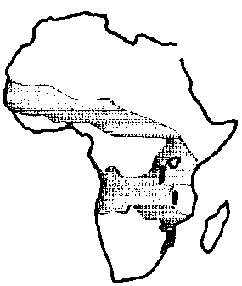
BIOLOGY
These are herbivores with a tendency to omnivory. They prefer fruits, but also subsist on tubers, grains, vegetables, leaves, legume pods, and wastes (such as banana peels). However, they are not grasseaters. Giant rats also kill and eat mice, insects (caterpillars, cockroaches, and locusts, for example), and probably many other small animals.3 They are particularly fond of mollusks (such as snails).
Reproduction is prolific and year-round. The female attains puberty at 20-23 weeks and the gestation period is about 20-42 days. The young are weaned at 21-26 days of age but stay with their mother until 2-3 months of age. So far, the record for the most litters has been 5 in 9 months. It thus seems possible that a female can reproduce 6 times a year. Litter size ranges between I and 5, but 4 is most common. Thus, in 1 year a single female could produce 24 or more young.
BEHAVIOR
These strictly nocturnal animals usually lead solitary lives and forage alone. Mostly, they occupy a burrow by themselves, except when the
young are being raised. The burrows can be complex. Below the entrances are vertical shafts leading to a system of galleries and chambers for storing food, depositing droppings, sleeping, or breeding. The home range is individual and limited (1-6 hectares). In the wild, one male "supervises" the home ranges of several females.
In captivity, the animals are often seen sitting up and ramming large amounts of food into their spacious cheek pouches. With full cheeks, they return to their burrows and disgorge the food into a "larder." Food (chiefly hard nuts) is stored there.
They swim and climb well.
USES
A study carried out in Nigeria showed that the giant rat produces about the same amount of meat as the domestic rabbit.4 The meat's nutritional value compares favorably with that of domestic livestock, and African villagers know how to preserve it by smoking or by salting.
The giant rat has recently attracted attention as a potential laboratory animal.
HUSBANDRY
Farmers in Nigeria have traditionally trapped the juveniles and fattened them for slaughter. They usually keep the animals in wire cages and feed them daily with food gathered in the wild as well as with scraps from the household.
As noted, the program at the University of Ibadan indicates that the giant rat can be domesticated. Already, specimens are being bred and reared in an intensive program. They adapt to captivity after about a month. They are subsequently transferred into breeding cages, which are wooden boxes with a rectangular wire-mesh "playroom." Each cage holds a breeding pair or a nursing female with its young. Experimental feeding cages have also been designed.5
Food-preference trials show that palm fruits and root crops (especially sweet potato) are preferred to grains and vegetables. Nutritional studies show that the animals can tolerate up to 7 percent crude fiber in their rations. Although largely vegetarian, they eagerly consume dry and canned dog food.
ADVANTAGES
These animals have several advantages:
· They are well known and much sought after for food.
· They have adapted to life in lowland tropics.
· They are able to live on locally available plant materials, including vegetable waste.
· They reproduce rapidly.
· They are more tolerant of captivity than the grasscutter (see next chapter). This is largely because omnivorous feeding makes them easier to feed than the grasscutter and other strict herbivores.
LIMITATIONS
This species could easily become a pest. It is recommended for rearing only in areas where it already exists. The crops it damages include cacao, root crops, peanuts, maize, sorghum, vegetables, and stored grains and foods. There is also the possibility that this rodent may transmit diseases to humans.
A project at the University of Kinshasa in Zaire reports problems in getting giant rats to reproduce in captivity. When two specimens were paired they sometimes fought so viciously that copulation was impossible.6 Special management may be required, such as housing animals in adjacent cages before actually introducing them to each other. Moreover, selection for docility may also be necessary.
The ratlike appearance is not attractive, and a few African tribes have taboos against consuming the meat of these animals.
RESEARCH AND CONSERVATION NEEDS
Throughout Africa south of the Sahara, giant rat domestication deserves experimentation and trials. Success would open up the potential for supplemental meat supplies in rural and urban areas where meat is now scarce. Tests are needed to determine the factors that favor breeding: temperature, aeration, light, privacy, and size and form of cages. Moreover, diets that are cheap and easy to make from local feedstuffs must be identified.
Further research on the domestication of the giant rat might include:
· Identifying husbandry techniques that are applicable at low cost in rural areas;
· Studying food digestibility and setting up various diets;
· Illuminating social behavior: pairing of animals, the best moment for pairing, duration of pairing, age of partners;
· Outlining the basics of husbandry (for instance, capital costs, food conversion ratios, growth rates) and making simple and cheap cages;
· Studying biology (anatomy, physiology, birth records, growth rate); and
· Testing the practical likelihood that this rodent may transmit diseases to people and other animals.
The giant rat has an interesting commensal relationship with Hemimerus, an insect that feeds on secretions in the skin. It seems to cause no irritation or damage, and may even benefit the host by helping to keep the skin clean. Caging these animals results in the general loss of the insect, but attempts should be made to maintain them and to determine their role and life cycle.7
The potential of this species as a laboratory animal in nutritional, clinical, and pharmacological research also deserves exploration.
19 Grasscutter
The grasscutter (Thryonomys swinderianus and Thryonomys gregorianus) is found in many forests and savannas of Africa. Its meat, said to resemble suckling pig, often sells for more per kilogram than chicken, beef, pork, or lamb. It is the preferred, and perhaps most expensive meat in West Africa. Indeed. in Ivory
Coast it sells for about $9 per kg. With prices like that, grasscutter is a culinary luxury that only the wealthy can afford.
If domestication of this wild species were successful in providing meat at a price similar to that of poultry (the second most popular meat), markets would be unlimited.2 However, as production costs are high, long-term research will be required before grasscutter production can be profitable to the small farmer. This research should now be undertaken.
In an effort to capitalize on the markets for this delicacy, agricultural extension services of Cameroon, Ghana, Ivory Coast, Nigeria, Togo, and particularly Benin are already encouraging farmers to rear grasscutters as backyard livestock. They furnish breeding stock and information, and maintain central offices for records. In addition, a bilateral cooperation project in Benin has started experimental work on improved breeding methods combined with the study of animal responses under domestication.3
In future, this vegetarian animal might become the African equivalent of South America's guinea pig, playing an important role in reducing Africa's chronic protein shortage.
AREA OF POTENTIAL USE
Humid and subhumid Africa south of the Sahara.
APPEARANCE AND SIZE
Grasscutters are robust animals with short tails, small ears, and stocky bodies. Taxonomically, they are more closely related to porcupines than to common rats or mice.
Although many varieties have been described, there are probably only two species. The larger (Thryonomys swinderianus) weighs 9 kg or more and has a head-and-body length of up to 60 cm. The smaller species (Thryonomys gregorianus) may occasionally reach 8 kg and a body length of 50 cm.
Both species have yellow-brown to gray-brown bodies, with whitish bellies. The fur is extremely coarse, firm, and bristly - reflecting the animal's kinship to the porcupine. The tail is scaly and has short, sparse hairs.
Both species have thick, heavy claws and enormous orange incisors that can chew through even the toughest vegetation. (Grasscutters have been known to tear holes in corrugated iron fences.) Nevertheless, they do not bite when handled, although their claws sometimes cause injuries.4
DISTRIBUTION
Grasscutters occur in grassland or in wooded savanna throughout the humid and subhumid areas of Africa south of the Sahara. They often live in forest-savanna habitats where grass is present. They do not inhabit rainforest, dry scrub, or desert, but they have colonized the road borders in forest regions. Distribution is determined by availability of adequate or preferred grass species for food. Specifically, Thryonomys swinderianus occurs in virtually all countries of west, east, and southern Africa. Thryonomys gregorianus occurs in savannas in Cameroon, Central African Republic, Zaire, Sudan, Ethiopia, Kenya, Uganda, Tanzania, Malawi, Zambia, Zimbabwe, and Mozambique.
STATUS
Despite heavy hunting, these animals are not threatened with extinction. Nonetheless, many individual populations are well below carrying capacity, or are extinct because of local overexploitation.
HABITAT AND ENVIRONMENT
The larger grasscutter (T. swinderianus) generally lives in swampy, low-lying areas, especially along river banks and the borders of lakes and streams. Occasionally, it is found on higher ground among bushes and rocks, living where savanna grasses are dense and tangled enough to afford good cover. In Ivory Coast and southern Guinea, for instance, grasscutters are found (and hunted) throughout the savanna zones. And they can occur in close proximity to farmlands and people (for example, in southwest Nigeria).
BIOLOGY
Although the precise diet in the wild has not been determined, grasscutters are vegetarian. They consume nuts, bark, and the soft parts of grasses and shrubs. They particularly favor elephant grass and sweet potatoes. They commonly "raid" cassava and yam plantations, and are considered local pests.
Grasscutters reproduce year-round, although the births seem to peak at certain times of the year, correlated with weather conditions.5 Probably one male takes several females, and the family group possibly has more than one generation of young. The gestation is about 152 days. Apparently, litters normally contain between 2 and 4 young, but in Benin and Togo some litters of up to 11 or 12 are reported.6 Newborns are fully developed, their eyes are open, they weigh approximately 80 g, have thick fur, and quickly become accomplished runners.
BEHAVIOR
Although they commonly forage in groups, grasscutters are generally solitary. They are nocturnal, and they travel at night through trails in reeds and grass, often to water. Most specimens seen in markets are males, possibly because males lead the groups and are thus most prone to being trapped.
When alarmed, these animals stamp their hind feet and give a strange booming grunt. When fleeing, they can run very fast and, given a chance, will take to water. They swim with ease.
For shelter, grasscutters usually weave nests of matted vegetation or scoop out shallow burrows.
USES
In a broad geographic band across sub-Saharan Africa, cattle raising is severely limited by trypanosomiasis. There, other sources of animal protein, including rodents, are traditionally used. Thus, grasscutter meat constitutes an important food for many Africans. The animals are mostly caught and eaten by families for their own use, but some are sold in markets and especially in roadside stalls. Many families depend exclusively on selling bushmeat, particularly that of grasscutters. In Accra, Ghana, during one year, 73 tons of grasscutter meat were sold in the local market. This represented more than 15,000 animals. In southern Africa, too, people find that these rodents make tasty food, although they may cut off the tail to make the carcass look less ratlike.
The meat is usually eaten smoked, and is so much in demand that grasscutters are hunted in organized drives with spears, dogs, and sometimes fire. It is considered excellent, especially when cooked in soups and stews or barbecued.7 It has been described as resembling venison in flavor, but it is dark like the meat of wild duck.
HUSBANDRY
In the savanna area of West Africa, people have traditionally captured wild grasscutters and raised them at home. As an extension of this, organized grasscutter husbandry has been initiated in West Africa. The animals are provided with marshy, tightly fenced areas with plenty of plant cover. The young are harvested from these areas and raised separately.
Ghanaian researcher Emanuel Asibey, a pioneer of this research, reports success at getting such captive stocks to reproduce. To this end, farmers are provided with breeding boxes and foundation grass cutter colonies. They are taught how to rear and feed the animals for home consumption or for cash income. Basically, the farmers make available large sheds where the animals can move freely. To prevent escape, the walls may be reinforced with cement plaster. The farmers also provide piles of grass, sugarcane, and other foods. A grasscutter reportedly takes about a month to adjust to such confinement. High mortality can occur in this period. The average weight of a mature, home-raised grasscutter is 4-7 kg. The average killing-out (dressed carcass) is 64 percent.8
The Wildlife Domestication Unit of Ibadan University in Nigeria, another pioneer of rodent domestication, has also reported the potential of domesticated grasscutter colonies.9
Research on grasscutter breeding, husbandry, and feeding is similarly being implemented by the Ministry for Rural Development in Benin and at the Lacena in Ivory Coast (see Research Contacts).
ADVANTAGES
The demand for grasscutter meat is so large that it is not being met. Markets for it already exist over much of Africa,
LIMITATIONS
Grasscutters can devastate such crops as rice, sugarcane, soybeans, peanuts, yams, cassava, sweet potatoes, oil-palm seedlings, maize, young rubber, sorghum, and wheat. Therefore, as with most rodents, they should be reared only in areas where they already exist.
In past years, captive animals in Benin have suffered fatal Clostridium infections during September and October. In 1986, a broad-spectrum antibiotic was given with outstanding results. During this season, the animals also suffered from ascarid worms, which were also successfully treated with standard drugs.10
RESEARCH AND CONSERVATION NEEDS
Research is needed in the following areas:
- Digestive physiology, feeding habits, feed preferences, feed conversion and growth rate;
- Diseases (pathogens and parasites);
- Captive breeding and management (growth rates, space requirements, feed needs, etc);
- Performance under different environments;
- Productivity; and
- Basic biology (for example, chromosome type, reproductive physiology, and social behavior both in its wild state and under controlled conditions).
Moreover, specimens should be gathered from different regions for comparative evaluation. A particular need is to select and breed docile specimens because today, even after several generations in captivity, the animal must still be handled with caution.
Although domestication of the grasscutter is encouraged, wild populations might also be managed to maximize and sustain production through habitat manipulation.
20 Guinea Pig
Guinea pigs (Cavia porcellus) are promising microlivestock because they require little capital or labor; provide an inexpensive, readily available, palatable meat; have no odor, and are suitable for keeping indoors. In the highlands of the Andes, many Indians raise them to supplement diets based on grains and vegetables. Families eat them mostly on special occasions such as weddings and first communions, or they sell them to restaurants or peddle them in village markets.
The low cost of these small animals makes them available even to many landless peasants. For both the small farmer and apartment dweller, the guinea pig is a possible food reserve. It converts kitchen scraps and marginal wastelands into meat. According to estimates, 20 females and 2 males may produce enough meat year-round to provide an adequate meat diet for a family of 6.2
Since husbandry practices are simple and cheap, the guinea pig is an excellent source of supplementary income. An FAO study at Ibarra, Ecuador, showed that on small mountain farms the guinea pig provided more profit than either pigs or dairy cows, partly because its meat fetched high prices.
Although domesticated guinea pigs are mainly a food resource of Latin America, their use has also spread to parts of Africa and Asia. They are raised, for instance, in Nigeria, Cameroon, Ghana, Sierra Leone, Togo, and Zaire. In southern Nigeria, at least 10 percent of all households raise guinea pigs for food, with colonies of up to 30 animals per household. Guinea pigs are also raised in small cages or cardboard boxes by small farmers in the Philippines.3
The feeding efficiency is high: studies have shown that it takes between 3.2 and 5.7 kg of forage to produce 1 kg of growth. This makes guinea pigs more efficient than most farm mammals.
Guinea pigs seem especially adapted to the climate and forages of high-altitude zones, but the fact that they are being raised in Central and West Africa indicates that they are also adapted to the lowland tropics.
AREA OF POTENTIAL USE
Worldwide.
APPEARANCE AND SIZE
Guinea pigs have stocky bodies, fairly short hind legs, and short, unfurred ears. Adults can weigh up to 2 kg, but an average-sized specimen is about 0.5 kg. They are 20-40 cm long (average 28 cm) and have no tail. In domesticated forms, the pelage may be smooth or coarse, short or long, and in some types the hairs form rosettes.4 Domesticated types come in colors ranging from white to dark brown, as well as piebald.5
DISTRIBUTION
The original home of the wild guinea pig is believed to have been the central highlands of Peru and Bolivia. Its domesticated descendants are important as meat animals mainly in that same area, but, as noted, they are also important in certain African and Asian countries.
A few strains are distributed worldwide as laboratory animals and pets.
STATUS
Domesticated guinea pigs, as a whole, are in no danger of extinction, although some rare strains are threatened.
HABITAT AND ENVIRONMENT
These extremely adaptable animals are found in temperate zones and in the highland tropics, but they are usually kept indoors and protected from the extremes of weather. In Lambayeque and other departments of Peru, they are reared at elevations from sea level to more than 4,000 m. In areas where they are raised, daily temperatures fluctuate as much as 30°C. In the Bolivian or Peruvian puna region, for instance, day temperatures can be 22°C, while night temperatures are -7°C. However, they cannot survive freezing temperatures and they may not perform well when exposed to the full tropical heat and sunlight. Many people of the Peruvian highlands keep the animals in darkness (for example, in wood boxes with little or no light).6
The animal's original wild habitat is believed to have been an area of grasslands, forest edges, swamps, and rocks.
BIOLOGY
These herbivores can be raised on kitchen scraps, garden wastes, and weedy vegetation plucked from backyards or roadsides. Andean peasants mainly feed them potato peels, scraps of cabbage, lettuce, carrot, wild grasses, corn stalks, and the foliage of miscellaneous wild plants. Some barley and alfalfa is grown specifically for guinea pigs; it is cut green and sold in small bundles in the markets.
Guinea pigs mate throughout the year except when climate is excessively adverse. Domestic breeds average 2-3 young per litter, although larger litters sometimes occur. The gestation period is 65-70 days with an average of 67. Females come into estrus every 13-24 days, and there is a fertile postpartum estrus.
Females can become pregnant when merely 3 months old, and many produce 4 litters every year from then on. In principle, a farmer starting with 1 male and 10 females could see his herd grow to 3,000 animals in one year.
Newborns are so large that the female's pubic bones must separate for the birth. They emerge fully developed, with fur and open eyes. They look like miniature adults, and they start eating grass and other feedstuffs within hours. (For this reason, babies orphaned at birth have been known to survive.) Weaning may be reached as early as 21 days of age.
The life span in captivity is as long as 8 years, but animals used for breeding usually live only 3.5 years.
SUPER GUINEA PIGS
Even in their native region, guinea pigs have traditionally received little research attention. However, that began changing in the 1970s with the onset of meat shortages in Peru. (For a time the government restricted beef sales to only 15 days a month.)
For instance, in 1972 Peru began a guinea pig improvement project. Researchers from i a Molina National Agrarian University traveled throughout Peru gathering many kinds of guinea pigs short haired long haired black, white, yellow, brown, and even purple. Practically all the guinea pigs eaten in Peru are home grown, and researchers observed that the bigger ones were generally winding up in the stew, leaving the smaller ones for breeding. The people inadvertently were making the animals smaller. (This is a common phenomenon for many animals.)
To overcome it, the university research workers compared the mature size and growth rates of all the different guinea pigs. They selected and cross-bred the biggest, meatiest, and fastest-growing ones. This program, later taken over by Instituto Nacional de Investigacion y Promocion Agropecuaria (INIPA), produced remarkable results. The starting animals averaged little more than 0.5 kg, the resulting ones averaged almost 2 kg.
Peru's "super guinea pigs" are now getting international recognition. They have been introduced into the highlands of Honduras, where the animal is also part of the Indian cuisine. The FAO has shipped some to the Dominican Republic. In addition, Bolivia, Ecuador, and Colombia have all begun their own guinea pig improvement programs.
Within Peru the government has established 11 breeding stations to encourage the farming of guinea pigs for food. The goal is to provide better stud males to the people so that future animals will grow more quickly and reach a greater weight.
BEHAVIOR
Guinea pigs generally congregate in small groups, normally made up of 5-10 adults. In favorable areas, however, such groups may coalesce into large colonies. The animals communicate incessantly among themselves, emitting a variety of squeaks and other noises.
Males, although good-natured with other species, often fight fiercely among themselves.
USES
Guinea pigs are raised mainly for meat. Peru has about 20 million, which annually provide 16-17,000 tons of meat (only 4,000 tons less than Peru's sheep meat production).
Guinea pigs are used worldwide for studies on disease, nutrition, heredity, and toxicology, as well as for the development of serums and other biomedical research.
HUSBANDRY
Guinea pigs require so little space that a small cage or pit can house up to 10 females and 1 male. They can be raised in cages with wire floors of small mesh as well. The labor required is low. A colony of 1,000 females reportedly can be properly cared for by one person. A layer of wood shavings, shredded paper, straw, and dried corncobs is usually recommended for bedding. The droppings are odorless, so the bedding does not need changing as often as with other animals. When the diet mainly consists of greens, much urine is produced, and then the beds have to be changed frequently.
When grown for meat, the young are weaned at 3-4 weeks and are ready for market in a matter of 10-13 weeks. Weight gain is rapid for the first 4-6 weeks, and then decreases. The carcasses normally dress out at about 65 percent, including the skin and legs. The meat's protein content is approximately 21 percent.7
In a few regions of Peru, guinea pigs are "herded" on the open range and retired at night into small adobe coops.
ADVANTAGES
This small, inoffensive animal rarely bites, is easy to manage, and has no smell. It is an excellent supplemental meat supply. The improved breeds cannot climb or jump so that they are easy to contain. (Primitive "criollo" types, however, can jump.) If kept dry and given green vegetation, grain, and water, it survives in many environments.
LIMITATIONS
A major constraint is consumer reluctance. Even in Latin America, attempts to promote guinea pig consumption outside the Indian communities have failed.
When raised in a clean environment and under normal feeding conditions, guinea pigs thrive and reproduce and do not need routine vaccinations or antibiotics that cattle, sheep, and pigs often require. However, guinea pigs can be carriers of Chagas' disease and salmonella. Further, they are susceptible to pneumonia if temperatures change abruptly when conditions are wet. Coccidiosis and internal and external parasites are also common.
Green forages and surplus fruits or by-products are critical to provide vitamin C, which the animal is unable to synthesize for itself.
RESEARCH AND CONSERVATION NEEDS
Since the greatest concentration of guinea pigs is found in the Andes, particular efforts should be directed towards this region. Already, research on guinea pigs has begun in some universities and government research stations in Colombia, Ecuador, Venezuela, Peru, and Bolivia, but more work is needed on matters such as:
- Breeding "elite" stock for distribution;
- Feeding and nutritional-requirement trials, especially for creating alternate feeds that peasants and commercial producers can use during seasons when conventional feeds are hard to get;
- Diseases and parasites that may limit production in small farming systems;
- Management practices concerning reproduction, housing, herd size, and feeding; and
- The genetic basis for weight gain and productivity.
Some research should be directed towards developing rations or introducing drought-resistant forages for the dry season because green forage is needed year-round. A range of practical and economical diets needs to be created.
Animal geneticists in Latin American countries should establish "elite" populations that can provide superior stock throughout the world. It can be anticipated that applying modern breeding methods to existing improved strains will result in great advances in a relatively short period and at little cost (see sidebar).
Three species of wild cavies (Cavia aperea, C. fulgida, and C. tschudii), close relatives of the guinea pig, are native to South America and are declining drastically. Research to preserve them is urgently needed. C. aperea is a widely used item of food in rural Brazil and other parts of South America.
21 Hutia
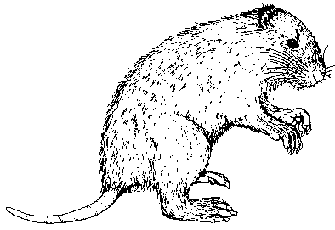
The first meat Christopher Columbus tasted in the New World was probably hutia, a rodent avidly hunted by the Carib Indians. Hutia bones have been unearthed from kitchen middens of pre-Columbian inhabitants of all the Greater Antilles. Indians carried live hutias on voyages possibly in a semidomestic state as a source of food. On some islands, hutias were so eagerly sought that their populations were destroyed long before Europeans arrived. Slaves in the cane fields also hunted hutias for food. The surviving species later suffered when forests were cleared and cats, dogs, mongooses, and other predators were introduced. Consequently, the majority of hutia species died out, and today most surviving members of the family (Capromyidae) are facing extinction. Human predation continues in some areas (for instance, in Jamaica) where the tradition of "coneyhunting" still endures in a few regions.
Hutias should be tested as possible microlivestock: success could create the incentive for their complete protection. The animals seem to take well to captivity. The Jamaican hutia is already overproducing in zoos, causing a local glut of animals. And hutias are, or were until recently, kept in barns by some people in Cuba, who fed them on banana and other vegetable waste and ate them regularly.'
POTENTIAL AREA OF USE
The Caribbean.
APPEARANCE AND SIZE
Hutias are broad-headed, short-legged, robust animals with small eyes and ears. The various species are from 20 to 60 cm long and weigh from 1 to 9 kg - a size range from that of a guinea pig to that of a small dog. They walk with a slow, waddling motion, but can hop quickly if frightened or pursued. They also climb well.
The 10 1iving species are all big enough to be candidates for microlivestock. The best known and easiest species to keep in captivity are the Cuban hutia (Capromys pilorides) and Jamaican hutia (Geocapromys brownii).
The Cuban hutia (also called hutia conga) is about 60 cm long, with coarse fur, a raccoon-shaped body, and a thick tail covered with sparse bristles. A forest dweller, it weighs up to 7 kg.
The short-tailed Jamaican hutia is smaller: it is 33-45 cm long and weighs up to 2.5 kg.
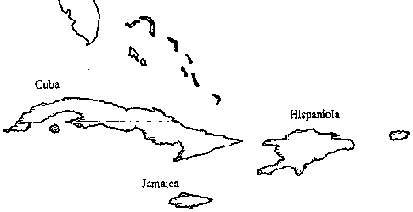
DISTRIBUTION
Hutias are found only in the Caribbean (Greater Antilles and Bahamas). Most species are confined to a single island, where they represent the only remaining indigenous land mammals. The Cuban hutia is found only in Cuba. The Jamaican hutia is found only in Jamaica, although a close relative occurs on East Plana Cay, Bahamas.
STATUS
This once widely distributed and plentiful family is now failing. Of the 30 or so known recent taxa, more than half are already extinct, and the remainder all suffer from habitat alteration, predation by introduced animals, and hunting by man. With the exception of the Cuban hutia, all species are included on the list of the world's threatened mammals.
HABITAT AND ENVIRONMENT
Hutia ranges have been so reduced that these animals survive only in the most inaccessible forests and rocky drylands. Both the Cuban and the Jamaican hutias occur in a variety of habitats from montane cloud forests to arid coastal semideserts.
BIOLOGY
Most species are terrestrial, but some live in trees. The Cuban and Jamaican species are terrestrial, but they can climb trees if circumstances demand. They maneuver well on trunks and larger branches, descending head first like squirrels.
Hutias are primarily vegetarian, their diets consisting of leaves, bark, fruits, and twigs, as well as incidental catches of small animals such as lizards and invertebrates.
Hutias seem to breed year-round, generally giving birth to litters of 1-4 offspring after a gestation period of 16-20 weeks. The young are well developed at birth, fully haired, open eyed, and capable of most adult movements. After 10 days they begin taking solid food, although they are not fully weaned for at least a month and a half (5 months for the Cuban hutia). Sexual maturity is at 10 months; life expectancy is 8-11 years in captivity.
The Jamaican hutia has one of the highest diploid chromosome numbers (2n = 88) of any mammal.
BEHAVIOR
Most hutias are wary and secretive and are easily displaced by human encroachment. They live like rabbits, hiding among tangled vegetation, in holes, and among rocks - communicating by voice and scent markings. They build shelters mainly in rock crevices, but also in the base of thick bushes or in natural cavities in trees. The Cuban hutia is often diurnal, whereas the Jamaican hutia is largely nocturnal.
HISPANIOLAN HUTIA
The Hispaniolan hutia, or zagouti (Plagiodontia aedium) as it is known in Haiti is smaller than the two Capromyids discussed here, weighing just 1.2 kg. It is difficult to breed in captivity and has a lower reproductive rate than either the Jamaican or Cuban hutia. It is therefore less suitable as an economic or food source.
However, there is a significant need for supplemental protein sources in both Haiti and the Dominican Republic. It might be possible to develop a special captive-breeding program for this animal, but it should be done with great care. It is important that a hunting tradition for this animal not be reestablished in rural areas of Haiti or the Dominican Republic, and that local organizations not be misled into believing that there will be a rapid increase in the numbers of this species in captivity.
USES
Hutia meat is relished, especially in Jamaica. The animals are still hunted, often by using dogs that smell them out and retrieve them from a hole or hold them at bay in treetops.
HUSBANDRY
Experiences of zoos suggest that the Cuban and Jamaican hutias will thrive in captivity. The animals are generally long-lived and have survived up to 17 years. They are often friendly with their keepers and, when tame, can be held and carried about without any particular danger. However, if angered they can inflict deep bites and should normally be handled with considerable caution.
ADVANTAGES
These animals are already much in demand. Their meat has an excellent flavor and they are big enough to provide a worthwhile quantity. If husbandry could be developed on a sustainable basis, it could be used as a mechanism for both economic development and for saving the remnant populations.
LIMITATIONS
Wild populations are threatened. Any captive population must be built up without endangering them.
All hutias are susceptible to predation by domestic cats, mongooses, dogs, and human poachers, so care must be taken to design predator-proof breeding facilities.
These animals are carriers of eastern equine encephalomyelitis, a serious disease of horses.
RESEARCH AND CONSERVATION NEEDS
Hutias deserve urgent conservation attention. In particular, the following steps should be taken:
- Establish reserves in natural habitats containing breeding populations to ensure the survival of the genetic diversity of these animals.
- Build up breeding populations in suitable zoos and livestock research centers.
- Gather specimens from different regions for comparative evaluation.
- Investigate hutia biology, including chromosome type, reproductive physiology, nutrition, and diseases.
- Assess experiences of zoos.
- Perform captive breeding trials, measuring growth rates, space requirements, food needs, and social behavior (both in its wild state and under controlled conditions).
- Study the social organization and tameability.
Colonies of some species could be established on uninhabited islands, as has been done with the Bahamian hutia Geocapromys ingrahami. Even this rare species might eventually be raised to yield meat for local inhabitants, as it is well adapted to dry and barren environments and was a regular food of the pre-Columbian Indians.
22 Mara
Many wild relatives of the guinea pig are native to South America. Some, such as the guinea pig itself, are small; others, such as the mare, are much bigger. Maras1 (Dolichotis patagonum) are as tall as terriers and, at first glance, look like dwarf antelopes or huge hares They have large ears and eyes, long legs, and short tails. They generally behave like hares or wild rabbits, but, like deer, they run with a stiff-legged gait when pursued by predators.
These strange-looking creatures are found in temperate regions in the southern half of South America. They are dry-country animals, living on the thorn-scrub, desert plains of Argentina and the stony wastes of Patagonia.
Although exceedingly shy, restless, and watchful, mares tame easily, make good pets, and are much favored by the local populace. They were introduced to France last century, and in Victorian times Europeans sometimes bred them. These big, handsome rodents, grazing in little herds, were considered an attractive addition to the lawns of country estates.
POTENTIAL AREA OF USE
Maras are best kept in their native region of southern South America. With care, however, they could be used in other areas because they are slow breeders and their population growth is easy to control.
APPEARANCE AND SIZE
At first sight, these large rodents look like some weird hybrid. They have the long ears of a hare and the tidy body and spindly legs of a small antelope. Although related to guinea pigs, they are long legged. The tail is short; the ears are long and erect.
Average-size mares weigh about 8 kg, but large ones can be 1 m long and weigh up to 16 kg.2 Females are larger than males. The coat is light in color, with grey upper parts and whitish underparts. The limbs and feet are tinged a yellowish brown. The pelage is dense, with individual hairs standing at nearly right angles to the skin. This gives a harsh texture, even though the hairs are soft and fine.
These animals can hop, walk, gallop, or run. They are extremely swift and can reach 45 km per hour over long distances. They are also accomplished jumpers, often leaping 2 m high from a standing start. The feet are compact and rather hooflike, but with sharp claws. The hind foot has three digits; the front foot has four.
DISTRIBUTION
The mare's range in the thorn-scrub desert and Patagonian steppe of Argentina extends from about 28°S to 50°S.
STATUS
Endangered. These animals, once plentiful, are now threatened because of the introduction of the European hare, which is more successful at competing for food. In many of the eastern parts of its distribution (see map) it is now extinct.
HABITAT AND ENVIRONMENT
Maras inhabit open, dry plains and other treeless semidesert areas of coarse grass or scattered shrubs.
BIOLOGY
Maras are pure vegetarians. They feed on short grasses and herbs that are sparsely distributed between patches of dry desert scrub. Usually, they are satisfied with a few coarse weeds and the shoots of bushes. However, their overall diet consists of any available vegetation: leaves, roots, fruits, and stems.
Female mares become sexually receptive within a few hours after giving birth. The estrous cycle is 35 days, plus or minus 5 days.3 The gestation period is 77 days. Each female gives birth to 1-3 young at the mouth of the den; the pups crawl inside to safety. Newborns are well developed, and within a few hours they begin grazing vegetation. They remain in the vicinity of the den for up to 4 months.
Initially, at least, the young are nervous and easily frightened.
BEHAVIOR
Maras shelter in a burrow that they either construct for themselves or "borrow" from another animal that has abandoned it. They are active during the day and spend considerable time basking in the sun. They are always alert for danger. When alarmed, they flee at high speed. The white rump patch flashes a warning to the others, who then follow this "flag."
A fundamental element of their social system is the monogamous pair bond. Certainly in captivity, and probably in the wild as well, the bond between a pair lasts for life. When breeding, 20 or more pairs may band together temporarily to share a single den for the pups.4
The animals stand on straight legs, sit on bent haunches with the forepart of the body resting on the fully extended front legs, or recline in a catlike position with the front legs folded under the chest, an unusual position for a rodent. They travel in single file, with the female usually leading. Members of a pair maintain contact by means of a low grumble. Although the long legs can quickly carry it to safety, a mare usually stops every 20-30 m and turns to peer at its pursuer.
The animals clean themselves by licking their sides and apparently by "combing" their fur with their teeth. They wipe their faces as cats do, with the inside of a foreleg.
USES
Although the light-colored meat is said to be dry and flavorless, it is widely consumed in South America.
HUSBANDRY
Maras have been successfully raised and bred in many zoos, and, as noted, have been kept as pets.
Adults make little use of any shelter; they seem fond of being out and about in all weather. As long as they have a protected burrow for the use of the pups, mare populations can thrive in severe climates.
In zoos, diets include straw, vegetables, and crushed oats. Drinking water is supplied, although the animals rarely take it if they are feeding on fresh plant materials. They like to have salt blocks, however.
In South America, one mare lived in captivity for almost 14 years; most specimens do not live beyond 10 years.
ADVANTAGES
Maras are a good size for microlivestock. They have a short gestation period, and they are social and easy to maintain in groups. They can be successfully kept in pens and can be fed relatively low-quality forage. Colonies can grow to be quite large.
LIMITATIONS
These animals can easily dig under the edges of cages and escape. Extra-deep foundations are needed.
Following heavy rains, care must be taken to keep them from drowning in their subterranean burrows.
If suddenly disturbed, mares can become hysterical, leaping away regardless of anything in the way, and often seriously injuring or even killing themselves as a result. They fear bodily contact.
The mare's monogamous nature in the wild is a likely limitation. But perhaps, like chinchillas, the animal will become polygamous in captivity.
The animals are sensitive to tuberculosis when kept in humid conditions.
RESEARCH AND CONSERVATION NEEDS
Research needs to increase understanding of the mare include:
- Nutritional trials;
- Husbandry experiments - measurements of growth rates, space requirements, feed needs;
- Productivity tests;
- Grazing-efficiency measurements;
- Exploration of commercial details; and
- Determination of diseases and parasites.
23 Paca
Pacas (Agouti paca)1,2 are large, white-spotted, almost tailless rodents with the potential to become a source of protein for the American tropics. They are found in lowlands from Mexico to northern Argentina. The meat is white and is considered the best of all Latin American game meat. It is common in local markets and restaurants. Tasting like a combination of pork and chicken, it sells at higher prices than beef and is a regular item of diet in some areas. In Costa Rica, pace is served on special occasions such as weddings or baptisms. It has a higher fat content than the lean meat of agoutis, rabbits, and chickens, and has no gamy taste.
Paca has promise as a microlivestock. In several countries, Belize and Mexico for example, people already keep them in cages beside their homes and fatten them on kitchen scraps. In Costa Rica, some are bred on farms, under houses, and even in apartments. Research on raising paces in captivity is under way at the Universidad Nacional in Heredia, Costa Rica; at the Smithsonian Tropical Research Institute in Balboa, Panama (see page 196); and at the Instituto de Historia Natural in Tuxtla Gutierrez, Mexico. In Turrialba, Costa Rica, an entrepreneur is already breeding and raising pace commercially.
While the pace has potential as a food source, many problems still must be resolved before it can be recommended for mass rearing. If solved, however, this species would become an attractive microlivestock.
AREA OF POTENTIAL USE
The pace has potential for use throughout its vast geographical range in Latin America.
APPEARANCE AND SIZE
In general appearance, paces are somewhat like giant guinea pigs. The legs are short, the forefeet have four "fingers," and the hindfeet have five small, hooflike "toes." The feet are partially webbed and are adapted both for digging and for swimming. Pacas burrow with all four feet as well as their teeth; even large roots are no obstacle.
Adults weigh 6-14 kg, males being somewhat larger than females. Although they may become bulbously fat, paces remain "one of the fastest things on four feet. " From a standing start, even a fat specimen can jump at least 1 m off the ground. Pacas are also agile. However, their skin's epidermal layer is thin and fragile, and large strips may be ripped off as they rush headlong through spiky undergrowth. However, such wounds heal astonishingly fast - frequently within days.
Pacas are chocolate brown in colon The head is somewhat lighter in shade than the body, and the underparts are whitish or buff colored. There are usually four longitudinal rows of white spots that may merge into stripes along each side of the body. The fur is coarse, spiny, and slippery, and has no underwool. Each hair is stiff, relatively sharp, and very smooth, which makes paces extremely difficult for predators to hang on to.
Parts of the cheekbones are enlarged, and the cheeks can open to form special pouches. This is more developed in adult males than in females - indeed, adults can be readily sexed by head shape. The pouches are outside of the mouth and are fully haired. The animals use them mainly to create a resonating chamber for their booming bark and noisy tooth grinding. These enlarged cheeks push the large bulging eyes toward the top of the skull. The eyes are suited for nocturnal conditions, the senses of smell and hearing are uncannily acute, and there is an array of long whiskers that is used when maneuvering at night.
DISTRIBUTION
Lowland paces are found throughout most of Latin America from east central Mexico to northern Paraguay, Argentina, and Minas Gerais, Brazil. This includes all of Central America and most of Colombia, Ecuador, Peru, Venezuela, and the Guianas. The animal has also been introduced into Cuba.
STATUS
Burgeoning human populations are severely reducing many of Latin America's native animal resources, and the pace is one of the most persecuted. It has been exterminated within hunting range of virtually all cities, towns, and villages.
Several governments, recognizing the pace's plight, have passed laws prohibiting the hunting and marketing of its meat. Nevertheless, people continue to take it, usually at night, using trail dogs and headlights.
HABITAT AND ENVIRONMENT
Pacas thrive in a variety of tropical habitats but are most common in forests, swamps, and partly cleared grazing lands. They inhabit most types of forests from deciduous woodland to rainforest. Usually, they stay near streams or rivers, but they often live where there is no permanent water. They are abundant only in little-disturbed forest areas. Although preferring low, dense tree cover, paces sometimes inhabit open rocky areas and farmland.
BIOLOGY
These herbivores feed mainly on fruits, young seedlings, and some seeds. However, when fruits are scarce they may switch to browsing leaves and roots. They probably sometimes eat large insects, and, on rare occasion, may perhaps eat small vertebrates. Captive paces, like many other "frugivores," seem to develop a protein deficiency and will eagerly eat meat scraps on occasion.
The young are usually born singly after a gestation period of 146 days. There are probably 2 births a year. Females have an estrous period that begins shortly after giving birth. If mating does not take place at this time, the female becomes unreceptive until after the 3-month (sometimes 4- to 6-month) lactation is over. The length of the estrous cycle is 30 days.
During daylight hours, paces seclude themselves in brushy cover, in or under fallen logs, or in extensive underground burrows. The burrows, which may be several meters long, are dug in moist soil or taken over from other animals; they are often in river banks, on slopes, among tree roots, or under rocks. Usually, several exits are provided, often being plugged with leaves as a disguise.
BEHAVIOR
In the wild, paces dig large holes and rummage about the forest floor at night, gnawing on fruits. Pairs inhabit a defended area, sometimes living together in the same burrow, sometimes not. Also, they usually travel alone, following paths that lead to feeding grounds and water. Individual home ranges are small (1-3 hectares).
Although paces are terrestrial, they enter water freely, they swim well, they copulate in water, and, when alarmed, they generally attempt to escape by swimming. They are also lively and playful; however, they can be exceedingly obstinate. Sometimes fighting among themselves becomes very savage. When angered they growl, sometimes noisily, and they can suddenly jump on aggressors, real or imagined, delivering frightful wounds with their chisel-like front teeth thrust forward like a spear.
USES
As noted, pace meat is tasty and brings high prices in the markets. It is considered a delicacy in fine restaurants and was served to Queen Elizabeth during her October 1985 visit to Belize. In Mexico, paces, like pigs, are usually boiled unskinned. Even the skin is then edible.
HUSBANDRY
If treated appropriately when young, paces become manageable. They undergo "imprinting," a characteristic of most species that have been domesticated. An imprinted pace becomes so tame that it seeks out human company, follows people around like an amiable dog and, if turned out of its cage, returns voluntarily. (To achieve this degree of tameness it is necessary to remove the animal from its mother at an early age.)
Although wild paces are almost entirely nocturnal, tame paces are more active during daylight hours.
Young or partly grown paces are commonly exhibited in zoos. They eat prodigious quantities of almost any vegetation and have been called, "a good substitute for a large garbage pail." Diets can include rolled oats, raw vegetables, bananas, apples, and bread. They probably need additional protein occasionally, and seem to appreciate some fat in their diet.
ADVANTAGES
If husbandry can be developed, the clamor for pace meat throughout tropical America would be a big economic incentive for farming these animals. The excellence and wide acceptance of the meat is an indication that pace farming would be taken up both in rural and urban areas and by many levels of society.
LIMITATIONS
Pacas can harbor human diseases, including leishmaniasis and Chagas' disease.
Apart from the project in Panama (see page 194), paces have bred only sporadically in captivity, with few offspring surviving. However, successes have been recorded in zoos in London, San Diego, and Washington, D.C., and in a research project in Tuxtla Gutierrez, Mexico. In Costa Rica, they are also reportedly breeding well, with a survival rate of 90 percent since 1982, and 80 percent of the females are reproducing.3
All adult paces can be aggressive and dangerous. Their powerful incisors can inflict serious wounds. (They can even rip through planks.) Intraspecific aggression is one of the most serious impediments to captive breeding.
Unlike the capybara, the pace not only has a long gestation but usually bears a single young. Thus, the output of a single breeding female may be, at best, two offspring per year (at least this is the expected production in the wild). This "slow" breeding is a limitation. In captivity, however, there is a possibility that it can be speeded up.4 The fact that paces bond together in pairs is a limitation. If every female has to be accompanied by a male, then many (otherwise unnecessary) males have to be fed and maintained.
Male paces are considered difficult to keep as household pets because they spray females (or human substitutes) with a mixture of urine and glandular secretions. This can occur several times a day. In addition, they have anal glands that produce a musky odor that some people find objectionable.
RESEARCH AND CONSERVATION NEEDS
Although paces are common in some areas over the vast region from Mexico to Argentina, they are little understood, even by zoologists. In fact, most data concerning this animal have come from interviews with local hunters. Intensive field work is needed to develop an understanding of the pace's biology, status, and habitat requirements.
The popularity of pace meat makes it urgent to start this work as well as to begin breeding paces on an organized basis. Such projects would lay the groundwork for preserving the species.
Particular research needs concern the following:
- Age structure and reproductive performance;
- Growth rates and feeding habits;
- Behavioral patterns in captivity;
- Nutritional requirements;
- Meat quality;
- Helminth and arthropod parasites;
- Role in transmitting or perpetuating diseases;
- Reproduction (such as external manifestations of estrus in females); and
- Genetic variations that would allow the selection of animals adapted to captivity and females that produce multiple offspring - twins, triplets, or more.
Ways must be found to introduce more than one female to each male without inciting aggression.
24 Vizcacha
Vizcachas (Lagostomus maximus) are soft-furred South American rodents that look like long-tailed guinea pigs. They can weigh as much as 8 kg and are resilient animals, inhabiting dry pampas and shrub lands in northern Argentina and neighboring countries. They seem to have promise for producing meat and hides in marginal zones whithin their native habitat.
Like chinchillas, these rodents provide a prized furry pelt. They also provide meat that reportedly tastes "as good as hare," which in Europe is considered the epitome of dining. They are easily trapped alive in cheap, homemade, multiple-catch, funnel traps. And they are thought to be suitable for farming on a large scale.
On the other hand, vizcachas are currently considered pests because they take grazing from cattle and sheep and because they build large burrows that undermine the land. Government campaigns have eradicated them in the richer agricultural areas of Argentina, but the animals are still common in marginal zones. There is evidence that they become more abundant when domestic livestock overgraze the land. In improverished marginal sites, where other livestock enterprises are unsuitable, the potential exists for game-ranching vizcachas.
AREA OF POTENTIAL USE
Because of the potential hazard to new areas, vizcachas can be used only in the pampas regions of southern South America where they are already widespread.
APPEARANCE AND SIZE
Vizcachas have short front legs, long, muscular hind legs, and round eyes and ears. Their heads seem oversized in proportion to their bodies. Males weigh 5-8 kg, females 2-4.5 kg.
Members of the same rodent subfamily as the chinchilla, they have a thick, soft, valuable fur that is grey or brown above, whitish or greyish below. They are, however, much larger than chinchillas.
Although basically running animals, vizcachas often jump bipedally (like kangaroos), and they sit erect while eating or grooming. The forefeet have four long flexible digits used to grasp food. Their soles and palms are naked and have fleshy pads (pallipes).
DISTRIBUTION
Vizcachas once swarmed widely over the savannas of southern Paraguay, Bolivia, and Argentina, but they are being systematically exterminated. Today they inhabit isolated areas of north, central, and western Argentina and southern Paraguay.
STATUS
Since 1907, these animals have been mercilessly hunted. The governments of the Argentine provinces where they are mostly found, reward hunters for killing this "pest." However, the numbers are so reduced that now there is no need for a bounty system.
HABITAT AND ENVIRONMENT
Vizcachas live in flat, dry, steppelike plains; in dry woodland (Chaco), and in low mountains.
BIOLOGY
The fact that these rodents eat their own droppings (coprophagy) augments their ability to utilize natural forages, and allows them to abound in degraded zones. They feed on any plant materials they can find near their colonies, particularly grasses. In feeding trials, their daily dry matter intake was 2-5 percent of the body weight. The metabolic efficiency (dry matter per kg) was 33-56 percent; the digestive efficiency was 50-60 percent.2
Male vizcachas become sexually mature at about seven months of age and remain fertile throughout the year. The gestation period is long: 154 days. Litters contain one or two young. Newborns are well developed, fully furred, and open eyed, although they cannot fend for themselves for at least three weeks. In the wild, one or two litters are reared each year.
BEHAVIOR
Vizcachas are nocturnal and are active year-round. They inhabit underground burrows, living in colonies often containing many individuals. They collect a variety of materials (for example, bones, sticks, and stones), and heap them in piles above the entrances to their burrows.
Their hearing and sense of smell are acute.
USES
Vizcachas have long been hunted for food as well as for their fur. Their meat is often consumed in pickled form in southern South America.
The skins are fabricated into table runners, rugs, bedspreads, slippers, and belts. The skins are also popular for overcoats.
Vizcachas can be kept in captivity without major difficulty.
HUSBANDRY
In zoos, vizcachas are fed the typical diets furnished for vegetarian rodents: rolled oats, green vegetables, bananas, apples, and bread. They are usually kept indoors in wire-fronted cages, about 1 x 2 m in size, and provided with sleeping boxes.
Little is known about vizcacha husbandry, but in one trial, weight rose most rapidly in males until age 18 months (the average size was then 5.3 kg) and subsequently slowed. The heaviest male was 7.3 kg at 30-32 months. The female's weight gain was greatest until 16-18 months (average size 3.3 kg).3
ADVANTAGES
The animals seem well adapted to harsh sites where the climate and forage make raising conventional livestock difficult.
The meat is white and has a good nutritive value because of its high digestibility, low levels of saturated fats, and high levels of proteins.
In marginal zones of the pampas, these rodents appear far more productive than traditional livestock.4
LIMITATIONS
Vizcachas may do considerable damage by foraging in cultivated crops. As noted, ranchers claim that they take grazing away from domestic animals, 10 vizcachas eating as much as a sheep. In addition, they claim, vizcachas destroy pasture with their acidic urine. And the large burrow systems sometimes create a hazard.
Because their reproductive rate is low and their growth rate is only moderate, their commercial breeding might not be profitable except in well-designed projects with clear markets.
Vizcachas require sturdy pens, which implies a high initial cost for materials such as concrete and brick.
Vizcachas can be aggressive to one another, especially in captivity.
RESEARCH AND CONSERVATION NEEDS
There are several possible research projects, including:
- Gathering specimens from different regions for comparative evaluation of characters such as biology, chromosome type, reproductive physiology, social behavior (both in its wild state and under controlled conditions);
- Attempting captive rearing and small-scale husbandry;
- Assessing performance under various environments; and
- Quantifying productivity and population dynamics in relation to rangeland use and improvement practices.
A rational cropping program based on wild stocks is perhaps more viable than captive breeding. This could be organized so as to keep vizcacha numbers in check while sustaining a small chain of processing plants by providing a constant supply of meat and skins.
25 Other Rodents
The 10 previous chapters have described some rodent species that show promise as microlivestock. Rodentia, however, is one of the largest families of mammals, and the species highlighted by no means exhaust the possibilities. In this chapter we briefly mention others that deserve consideration and exploratory research. These might prove to be potential resources, at least in localized situations. Several are fast nearing extinction and they deserve protection and immediate attention from animal scientists.
CHINCHILLAS
In the high Andes of South America are found the short-tailed chinchilla (Chinchilla brevicaudata) and the long-tailed chinchilla (Chinchilla lanigera). These plump little rodents have fur that is possibly the thickest, softest, and warmest of any animal's.
On the surface they would seem to be ideal candidates for microlivestock in Third World regions. Indeed, in recent years chinchilla-rearing has been successfully carried out in northern India. However, raising these animals for commercial markets is a highly specialized and costly business because only rare and expensive breeding stock produces top-quality pelts, and all other pelts are worthless in today's marketplace.
These guinea-pig-sized animals have round ears, a bushy tail, and range from 25 to 50 cm long. Adult males rarely weigh more than 500 g, but females may weigh up to 800 g.
PACARANA
The pacarana (Dinomys branickii) is the third-largest living rodent- only capybaras and some beavers are larger. But little is known about this seldom-encountered, forest-dwelling species. Nevertheless, pacaranas appear to be likely candidates for domestication. They are amazingly even-tempered and peaceful, and become surprisingly tame.
Because these animals are endangered they are unlikely candidates for microlivestock in the short run, but their large size and good meat could be the stimulus for an international effort to study, protect, and rear them in large numbers before it is too late.
Pacaranas are found along the eastern foothills of the Andes, including parts of Bolivia, Brazil, Colombia, Ecuador, and Peru. Their area of potential use is in Latin America and the Caribbean.
It would be advantageous for livestock scientists to investigate this species in captivity. Studies are needed of the animal's general biology, including its nutritional requirements, reproductive capacity, behavior, and physiology. For wildlife specialists, there is a compelling need to protect this species.
SPRINGHARE
Scattered through the dry lands of eastern and southern Africa - on numerous grasslands, plains, fossil lake beds, hill slopes, and floodplains - is the springhare (or springhaas). With its powerful hind legs, tiny forelegs, upright stance, and hopping gait, it looks something like a tiny kangaroo. It is commonly seen at night, eyes glowing a characteristic red in the headlights.
This animal is an important source of food and skins for rural peoples throughout southern Africa. In Botswana, it is the principal bushmeat in the human diet.
Springhares are 35-40 cm long and weigh 3-4 kg. There is one species (Pedetes capensis) and two subspecies: the East African springhare and the Cape springhare (formerly Pedetes cafer).
ROCK CAVY
The rock cavy (Kerodon rupestris) is closely related to the guinea pig and occurs in the impoverished semiarid region of northeastern Brazil. It is large and lean and has a face somewhat resembling a dog's. It is hunted extensively and is an important source of meat for country people, who consider it a delicacy.
This creature might be suitable as a microlivestock. It consumes leaves and bark, and breeds well in captivity. Famine is a serious periodic problem in the often-drought-stricken area, and protein deficiency is common. The rock cavy, like the guinea pig, may be amenable to domestication and may be able to provide the people with better nutrition. However, it is difficult to keep in a cage because it moves fast, climbs well, and easily slips out.
Because these rodents occur in rare and patchily distributed habitats, they are in desperate need of protection, whether or not they prove to have any long-term utility.
SALT-DESERT CAVY
A smaller relative of the mare (page 256), the salt-desert cavy (Dolichotis salinicola) is rabbitlike in appearance and behavior. It has large ears and eyes, long legs, and a short tail. It lacks the mare's white rump patch.
This animal inhabits dry, salty areas of the Chaco desert, particularly areas of dry, woody brush. Specifically, it is found in the saline western Chaco of Paraguay and northwestern Argentina, as well as in the extreme south of Bolivia. It is about 45 cm long and weighs up to 4 kg.
Although it might make a useful microlivestock in its native habitat, the salt-desert cavy breeds rapidly and can cause much devastation; it should never be introduced to new regions.
The salt-desert cavy's life in the wild is largely unknown; however, some have been successfully raised and bred in zoos. Exploratory research on keeping and managing these little creatures is warranted.
OTHERS
As noted earlier (page 193), it has been estimated that 42 peoples of various cultures eat rodents. Most of these eat locally available species, some of which are listed below. Whether any have long-term usefulness is uncertain, but study of them in the wild and in captivity could result in some interesting and valuable scientific discoveries.
Solomon Islands Rodents
The Solomon Islands in the southwest Pacific are home to a collection of six rare giant rodents that live in the rainforest canopy. At one time they were important food items. Archeologists have dug up tens of thousands of rodent bones on sites where people lived as long as 30,000 years ago. These mysterious animals were classified last century, but most have not been seen by biologists for decades. However, one, the thinking rat (Solomys sapientis), was rediscovered in 1987 - the first time it had been reported seen since 1901. The others may also be inhabiting the dense and undisturbed forests.'
The thinking rat was located on the island of Santa Isabel. It proved to be gentle, unafraid, and friendly. It lives in the forest canopy, weighs up to 1 kg, and feeds on nuts and fruits. Efforts to build up the population are urgently needed. The other species should also be sought.
Such animals could be a resource for rainforest production (perhaps in the manner of butterfly farming in Papua New Guinea2). They may never be plentiful enough to be food sources again, but they could nonetheless become valuable. Zoos the world over are likely first customers for these scientific curiosities if production can be boosted and the populations secured.
Giant New Guinea Rat
The giant New Guinea rat (Mallomys rothschildi) is often eaten in New Guinea. It is little known to science but is odorless and easily tamed. It grows so fast that it becomes as big as a guinea pig even before it is weaned. It feeds on a wide variety of tubers and vegetable products. An attractive species native to mountain forests, it has a long heavy tail and black fur with white ticking.
Porcupines
Porcupines, brush-tailed porcupines, and their relatives are distantly related to guinea pigs and are widely consumed as food in tropical regions. Examples are:
- Indian porcupine (Hystrix indica) and other species of South Asia.
- Cape porcupine (H. africaeaustralis) of southern Africa.
- Prehensile-tailed porcupine (Coendou prehensilis), which inhabits Central and South America. These nocturnal creatures live in the thick, leafy crowns of trees or in hollow trees or holes in the ground. Although often belligerent among themselves, they can be very friendly and tame toward humans.
Kiore
The kiore (Rattus exulans) was formerly an important component of the diet of most Polynesians, including the Maoris of New Zealand. It has been successfully reared in captivity in recent times. Unlike many other rodents, this animal is normally not a scavenger; it is a clean, even fastidious feeder that is basically a vegetarian (flowers, berries, nuts, and seeds) and is reckoned remarkably good eating.
Soft-Furred Rat
The soft-furred rat (Praomys) is relatively large and slender and is found in the tropical forests of Africa from sea level to more than 3,000 m. Among the most common rodents of the African jungle, it is trapped almost everywhere. It feeds largely on plants, but eats large quantities of ants and other insects. It has been raised successfully in captivity and is eaten by villagers in Malawi.
Giant Squirrels
The giant squirrel (Ratufa bicolor) occurs throughout Indonesia, Malaysia, and Sri Lanka. It is the largest squirrel on earth, almost the size of a cat. A related species, the palm squirrel (Funambulus), also gets very large. It can crop nuts in the very high treetops that are inaccessible to people. It is widely used as food.
Squirrels
Squirrels of the genus Callosciurus (notably C. notatus and C. prevostii) are significant pests on cocoa, oil palm, and mixed fruit plantations in Southeast Asia. They can be reared and bred on a diet of most types of fruit as long as a little protein, in the form of insects or cooked wheat, is available. The systematic use of this animal may offer a chance to turn a pest to advantage.
Cloud Rat
Two species of slender-tailed cloud rats (Phlocomys spp.) are found only in southeastern Asia. They live in tree cavities, climb well, and are well adapted to tree life.
One of these (P. cumingi) lives in the northeastern part of Luzon in the Philippines, where it appears to be thriving. It has a large body and long tail and is the largest member of the mouse subfamily.
The other (Crateromys schadenbergi) has long, thick hair and a thick, bushy tail. It lives in the mountainous areas of northern Luzon. A nocturnal animal, it feeds on buds, bark, and fruits.
Both are attractive, even fascinating, creatures that are relentlessly hunted for food. They might make useful livestock in forest situations.
Spiny Rat
The Cayenne spiny rat (Proechimys guyannensis) is found throughout most of South America. It is tasty, easily kept in captivity, and is popularly used in Colombia for food. A nocturnal animal, it is one of the most common mammals in many areas. It has been raised in captivity on bananas, sweet corn, coconut, grain, and various seeds.3
Bamboo Rat
The bamboo rat (Rhyzomys spp.) is the largest rodent on the island of Sumatra in Indonesia; it weighs 2-4 kg and the body can be as long as 45 cm. It prefers to live in bamboo thickets and is hunted and eaten by many local peoples.
There is a need - in considering any sort of game farming - to relate the animal's "preferred" conditions (range, feed, temperature, etc.) to the varying land and climate types not being effectively utilized. In other words, rather than looking at animals that might be farmed, it might be necessary to consider the terrain and climate and then seek animals that would "do" well under those conditions. One major fault with traditional farming has been the tendency to force traditional livestock onto unsuitable land. This has given rise to numerous serious problems. In many cases the most suitable use of an area is provided by several species grazing together to mutual benefit (e.g., goats and sheep on New Zealand hill country improve grazing for each other if ratios are right).
